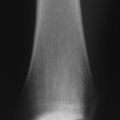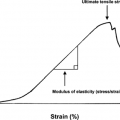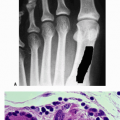Beckwith-Wiedemann Syndrome
Danielle A. Katz
Beckwith-Wiedemann syndrome is defined by the presence of macroglossia, omphalocele, and visceromegaly. Typically these children are seen by an orthopaedic surgeon for hemihypertrophy and/or cerebral palsy. It is thought that the cerebral palsy is the result of hypoglycemia and seizures in the neonatal period.
Pathogenesis
Etiology
Mapped to a mutation at 11p15, which is near the gene for insulin-like growth factor (11p15.5) and the gene for Wilms tumor (11p13)
Most mutations are sporadic.
Inheritance is autosomal dominant with evidence of paternal imprinting.
Epidemiology
Affects approximately 1:14,000
Associations with Beckwith-Wiedemann syndrome
Most babies are >90th percentile weight at birth.
Most are at the 97th percentile by 1 year of age.
15% of babies born with an omphalocele have Beckwith-Wiedemann syndrome.








